History
Padhiana is a remaining legacy of Minhas Confederation of villages. Minhas Rajputs of this village are descendants of Shri Baba Kati Deo Ji (alias Kati Ji), a feudal lord of the 16th century, who was a vassal to the Jaswal Raja (King) of Jaswan. Shri Kati Deo was the younger brother of legendary, Shri Mati Deo.
The founding ancestor of this village migrated from Daroli, today Daroli Kalan, when family fortunes split. The village today has seven Pattis (family branches). Detailed record of each Minhas family is maintained by genealogists in Hardwar, Uttarakhand.
In 1815, the village became a part of Sikh empire when territories of the Raja of Jaswan were confiscated by Ranjit Singh. Few decades later, following the second Anglo-Sikh war, it was transferred to British along with other territories of Punjab.
Historical personalities of this village include Sikh warriors, Sangat Singh Ji, Uday Singh Ji, and Bachiter Singh Ji; all served in the tenth Sikh Guru, Gobind Singh Ji's army. Later, Sikh Chiefs from this village served in the army of famous Sikh leader Banda Bahadur Singh Ji, who offered them a Fief (Jagir) which lies in what is today the Patiala district of Punjab. These Chiefs later built a fort and established Bahadurgarh village in their new land. A medieval well in Padhiana, although now sealed, still exists commemorating these Chiefs, and is called Bahadargarhian Da Khoo (the well of Bahadargarh Chiefs).
Prominent personalities from recent centuries include Col. Dilbagh Singh Minhas, the first Recruiting Officer at Jalandhar Cantt. The first Commander-in-Chief of the country, General K.M. Cariappa came to this village at the invitation of Col. Dilbagh Singh Minhas on 4 March 1949. Col. Dilbagh Singh Minhas who enlisted Punjabis in the Army, Navy and Air Force from Padhiana and surrounding villages. A prominent and well known personality in the Doaba region due to his charity work. Sardar Khajan Singh, a Safed Posh during British rule. His grandson Sardar Ujagar Singh was a member of Punjab Zila Parishad in post independence India. Sardar Dayal Singh of this village, who migrated to Kota Bundi, was a Member of Rajasthan Legislative Assembly in the 1950s. Er. Wattan Singh Minhas a Civil Engineering graduate from prestigious Thomson Engineering College, Roorkee (now, IIT, Roorkee) served as Chief Engineer in Central Public Works Department (CPWD). He is credited with construction of a number of Dams immediately after India's independence from British. His younger brother Captain Bhag Singh Minhas served the country as an army officer and in the martial tradition of the village is credited with active participation in the 1962, 1965 and 1971 wars. More recently, Sardar B.S. Minhas, an Indian Administrative Services officer, was Secretary (called Deputy Minister in some countries), Ministry of Small Scale Industries and Agro & Rural Industries of India, the highest position a public service officer can hold in Indian Government ministry.
In Military, Sardar Brigadier Manjit Singh of this village was awarded Maha Vir Chakra, India's second highest gallantry award, for his leadership in 1987 Jaffna operations of Indian Army. Major (later Brigadier) Varinder Singh Minhas, Vir Chakra, the officer, who successfully led Indian Army's famous Siachan operation against Pakistan in 1984 also has Padhiana origin. The operation won many gallantry awards to its participant soldiers, including a Param Vir Chakra to Sardar Bana Singh, the only soldier to ever win this award while alive.
Among media personalities, Bollywood models and actors, brothers Rahul Dev and Mukul Dev have Padhiana ancestry. Also, famous Punjabi poet, lyricist and TV show producer Lal Padhianvi grew up in Padhiana.
The village has produced many eminent scientists, army officers, educationists, administrators, and artists, some of which are listed in later sections.
A Brahman Lady's tomb commemorating her Sati stands near the village North crematory reminiscent of the medieval traditions of Padhiana gentry. The pond adjoining the crematory is called "Tal Satiwati" or, in English, "Pond of the Sati Lady".
Army officers of this village
(Excerpt from The Tribune dated August 11, 2006)
Although as many as 282 Army personnel, hailing from Padhiana village, have shown their valour in the World War I and World War II and more than 35 youth from the village still serve in the Indian Army, while some have joined the Indian Air Force has been ignored by the administration.
All the serving and over 400 ex-servicemen here say their courage and sacrifice has not been duly rewarded by the district administration. Their only demand to the administration — a Sainik Bhawan — is yet to be fulfilled.
While a hall, library room, meeting room and veranda has been completed in the past six years, the building is yet not ready for use, as there are no provisions for power connection, water supply, kitchen and toilets.
The village has an entrance gate in the memory of Subedar Bir Singh who fought in World War I as well as II. A stone erected outside a gurdwara pahari darwaja sahib ji in the village reads: "176 men went for war from this village from 1914 to 1919. Eight gave up their lives."
The first Commander-in-Chief of the country, General K.M. Cariappa came to this village at the invitation of Col. Dilbagh Singh Minhas on 4 March 1949. Col. Dilbagh Singh Minhas who enlisted Punjabis in the Army, Navy and Air Force, was the first Recruiting Officer at Jalandhar Cantt.
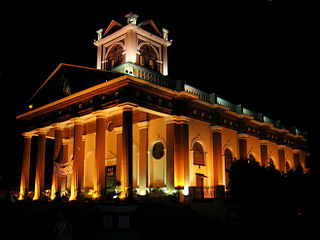
Kapurthala is a city in Punjab state of India. It is the administrative headquarters of Kapurthala District. It was the capital of the Kapurthala State, a princely state in British India. The aesthetic mix of the city with its prominent buildings based on French and Indo-Saracenic architecture self-narrate its princely past. It is also known as city of Palaces & Gardens. According to the 2011 census, Kapurthala is the least populated city in India.
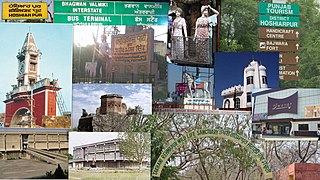
Hoshiarpur is a city and a municipal corporation in Hoshiarpur district in the Doaba region of the Indian state of Punjab. It was founded, according to tradition, during the early part of the fourteenth century. In 1809, it was occupied by the forces of Maharaja Karanvir Singh and was united into the greater state of Punjab in 1849.
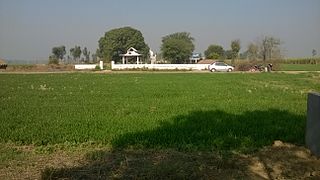
Hoshiarpur district is a district of Punjab state in northern India. Hoshiarpur, one of the oldest districts of Punjab, is located in the North-east part of the Punjab state and shares common boundaries with Gurdaspur district in the north-west, Jalandhar district and Kapurthala district in south-west, Kangra district and Una district of Himachal Pradesh in the north-east. Hoshiarpur district comprises 4 sub-divisions, 10 community development blocks, 9 urban local bodies and 1417 villages. The district has an area of 3365 km2. and a population of 1,586,625 persons as per census 2011.

Batala is the eighth largest city in the state of Punjab, India in terms of population after Ludhiana, Amritsar, Jalandhar, Patiala, Bathinda, Mohali and Hoshiarpur. Batala ranks as the second-oldest city after Bathinda. It is a municipal corporation in Gurdaspur district in the Majha region of the state of Punjab. It is located about 32 km from Gurdaspur, the headquarters of the district. It is also a Police district. Batala holds the status of the most populated town of the district with 31% of the district's total population. It is the biggest industrial town in the district.

Jalandhar district is a district in Doaba region of the state of Punjab, India. The district headquarters is the city of Jalandhar.

Doaba, also known as Bist Doab or the Jalandhar Doab, is the region of Punjab, India that lies between the Beas River and the Sutlej River. People of this region are given the demonym "Doabia". The dialect of Punjabi spoken in Doaba is called "Doabi". The term "Doaba" or "Doab" is derived from Persian دو آب meaning "land of two rivers". The river Sutlej separates Doaba from the Malwa region to its south and the river Beas separates Doaba from the Majha region to its north.

Majha is a region located in the central parts of the historical Punjab region, currently split between the republics of India and Pakistan. It extends north from the right banks of the river Beas, and reaches as far north as the river Jhelum. People of the Majha region are given the demonym "Mājhī" or "Majhail". Most inhabitants of the region speak the Majhi dialect, which is the basis of the standard register of the Punjabi language. The most populous city in the area is Lahore on the Pakistani side, and Amritsar on the Indian side of the border.
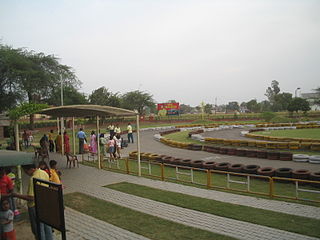
Jalandhar Cantonment is a cantonment town in Jalandhar District in the Indian state of Punjab. The Cantonment is located between latitude 30° 18' and longitude 75° 37' on the southwest and at a distance of 2 km from Cantonment Railway Station and 5 km from City Railway Station. It is situated beside Grand Trunk Road at a distance of 89 km from Amritsar and 371 km from Delhi. It covers an area of 5.87 square miles (15.2 km2). It is on Amritsar-Delhi Broad Gauge Main Line. A Class-I airfield at Adampur is situated at a distance of 19 km. The airfield is linked with Jalandhar Cantonment by rail and road. It has a Recruiting Office responsible for enlisting the soldiers for Army, Navy and Air Force. The first Recruiting Officer who held this post until 1952 was Col. Dilbagh Singh Minhas of Jallandhar Doab.

Subedar Joginder Singh Sahnan, PVC, was an Indian soldier and posthumous recipient of India's highest military award, the Param Vir Chakra. Singh joined the British Indian Army in 1936 and served in the 1st battalion of the Sikh Regiment. During the 1962 Sino-Indian War, he was commanding a platoon at the Bum La Pass in the North-East Frontier Agency. Though heavily outnumbered, he bravely led his troops against a Chinese assault and defended his post until he was wounded and captured. Singh died from his injuries while in Chinese custody. He single-handedly killed more than 50 Chinese soldiers, and became a war hero within the Indian Armed Forces.

Khalsa College is a historic educational institution in the northern Indian city of Amritsar in the state of Punjab, India. Founded in 1892, the sprawling 300-acre (1.2 km2) campus is located about eight kilometers from the city-center on the Amritsar-Lahore highway, adjoining Guru Nanak Dev University campus, to which Khalsa College is academically affiliated.
Balachaur is a town in Balachaur Tehsil in the Shaheed Bhagat Singh Nagar District of Punjab, India.
Mahilpur is a city and a Nagar Panchayat in Hoshiarpur district in the Indian state Punjab. It is situated on Hoshiarpur to Garhshankar stretch of State Highway 24. It is famous for the game of football in the region. Mahilpur is connected by road to nearby districts, states and towns such as Jaijon, Jalandhar, Pathankot, Mohali, Chandigarh. Mahilpur is a development block. Mahilpur block has 140 villages in it. It as also known as the soccer-town of India given the craze of football among the people of Mahilpur town and its surrounding villages. It belongs to the Sirowal area in the Doaba region of Punjab. Mahilpur had its first bank as Punjab National Bank in 1946 which operates two branches in the city. Mahilpur is famous for mangoes in the region.
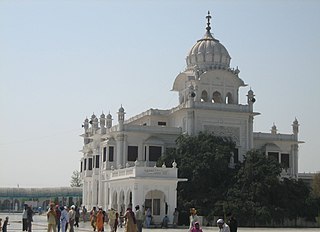
Sultanpur Lodhi is a city and a Municipal Council, just 17 miles Kapurthala city in the Kapurthala district in the Indian state of Punjab. The town is named after its founder, Bahlol Lodhi, the future Sultan of Delhi who renamed the town in 1443 C.E. during his time as governor of Punjab, and has also been mentioned in the Ain-e-Akbari. Sultanpur Lodhi is located on the south bank of a seasonal rivulet called Kali Bein, which runs 6 miles (9.7 km) north of the confluence of the Beas and Sutlej rivers of Punjab.
Urmar Tanda is a town and municipal council in Hoshiarpur district, Punjab, India.
Domeli is a village in Tehsil Phagwara, Kapurthala district, in Punjab, India.
Sajjana is a village in Hoshiarpur tehsil of Hoshiarpur district in Punjab, India.
Mao Sahib is a village and the birthplace of Mata Ganga in Jalandhar district of Punjab State, India. It is located 10 km from Phillaur, 14 km from Nurmahal, 47 km from district headquarter Jalandhar and 120 km from state capital Chandigarh. The village is administrated by a sarpanch who is an elected representative of village as per Panchayati raj (India).
Brigadier Manjit Singh Minhas, MVC was an officer of the Indian Army, who served with the Mahar Regiment and the 11 Jammu and Kashmir Light Infantry. He was awarded the Maha Vir Chakra, India's second highest award for gallantry in the face of the enemy, during Operation Pawan 1987 in Sri Lanka.












